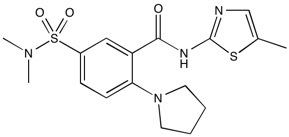NGI-1 | Oligosaccharyltransferase (OST) inhibitor
NMR (Conforms)

Available Options
| Size: | Price | Quantity | |
|---|---|---|---|
| 10 mg | $65.00 | ||
| 50 mg | $265.00 |
NGI-1 (790702-57-7) is a cell-permeable inhibitor of oligosaccharyltransferase (OST) – IC50 = 1.1 µM.1 It blocks cell-surface localization and signaling of the epidermal growth factor receptor (EGFR) glycoprotein and selectively arrests proliferation only in cells dependent on EGFR for survival. NGI-1 caused G1 arrest and senescence in RTK-dependent NSCLC cells (PC9, HCC827, H3255,H1581). NGI-1 displays antiviral behavior against various flaviviruses (Dengue, West Nile, Yellow fever and Zika).2 It also was able to overcome resistance to EGFR tyrosine kinase inhibitors in mutant NSCLC cells3 and enhance radiosensitivity and cytotoxic effects of chemotherapy in glioma cells with high levels of RTK activation4.
References/Citations:
1) Lopez-Sambrooks et al. (2016), Oligosaccharyltransferase inhibition induces senescence in RTK-driven tumor cells; Nature Chem. Biol. 12 1023
2) Puschnik et al. (2017), A small molecule oligosaccharyltransferase inhibitor with pan-flaviviral activity; Cell Rep. 21 3032
3) Lopez-Sambrooks et al. (2018), Oligosaccharyltransferase Inhibition Overcomes Therapeutic Resistance to EGFR Tyrosine Kinase Inhibitors; Cancer Res. July 19, 2018 Epub ahead of print
4) Baro et al. (2018), Oligosaccharyltransferase Inhibition Reduces Receptor Tyrosine Kinase Activation and Enhances Glioma Radiosensitivity; Clin. Cancer Res. July 2, 2018 Epub ahead of print
NMR (Conforms)
Safety Data Sheet:
Product Data Sheet:
Materials provided by Focus Biomolecules are for laboratory research use only and are not intended for human or veterinary applications. Please note that we do not sell to individuals and that all orders placed by non-research organizations will incur a $20 restocking/refund fee
NGI-1 (790702-57-7) is a cell-permeable inhibitor of oligosaccharyltransferase (OST) – IC50 = 1.1 µM.1 It blocks cell-surface localization and signaling of the epidermal growth factor receptor (EGFR) glycoprotein and selectively arrests proliferation only in cells dependent on EGFR for survival. NGI-1 caused G1 arrest and senescence in RTK-dependent NSCLC cells (PC9, HCC827, H3255,H1581). NGI-1 displays antiviral behavior against various flaviviruses (Dengue, West Nile, Yellow fever and Zika).2 It also was able to overcome resistance to EGFR tyrosine kinase inhibitors in mutant NSCLC cells3 and enhance radiosensitivity and cytotoxic effects of chemotherapy in glioma cells with high levels of RTK activation4.
References/Citations:
1) Lopez-Sambrooks et al. (2016), Oligosaccharyltransferase inhibition induces senescence in RTK-driven tumor cells; Nature Chem. Biol. 12 1023
2) Puschnik et al. (2017), A small molecule oligosaccharyltransferase inhibitor with pan-flaviviral activity; Cell Rep. 21 3032
3) Lopez-Sambrooks et al. (2018), Oligosaccharyltransferase Inhibition Overcomes Therapeutic Resistance to EGFR Tyrosine Kinase Inhibitors; Cancer Res. July 19, 2018 Epub ahead of print
4) Baro et al. (2018), Oligosaccharyltransferase Inhibition Reduces Receptor Tyrosine Kinase Activation and Enhances Glioma Radiosensitivity; Clin. Cancer Res. July 2, 2018 Epub ahead of print
Calculate the molar concentration, mass or volume in a solution.
Concentration × Volume × Molecular Weight = Mass
Focus Biomolecules • Plymouth Meeting, PA USA • 1-855-FOCUS21
Focus Biomolecules
Plymouth Meeting, PA USA
1-855-FOCUS21
Website Created by Advanta Advertising LLC.

